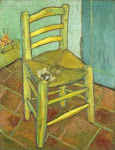
Julianne over at Writing the Renaissance has posted some interesting things lately about Lyon and the silk industry, so I thought I'd chime in today about van Gogh's artistic interest in professional weavers. While living in Nuenen with his parents, during a six or seven-month period (January-July 1884) Vincent made about thirty drawings, watercolors, and oil paintings of local weavers. These compositions allowed him to work on his perspective technique while exploring his interest in "peasant" subjects. As art historians have noted, however, these works present a contradiction: they possess a certain "utopian" viewpoint (Carol Zemel's word), an idealized view of peasant life, but at the same time an awareness that these men lived difficult lives in an era of increasing modernization. Van Gogh claimed to identify with these working-class artisans, but, ironically, his brother Theo gave him far more money than a Nuenen weaver would see per month. Vincent hoped his weaver pictures would find an audience among Theo's urban-bourgeois clients, but to his great aggravation, Theo thought them unmarketable.
The drawing seen here (Van Gogh Museum) dates from Jan-Feb 1884 and is one of the earliest in the series. The inclusion of a baby at right is interesting. The possible influence of George Eliot's "Silas Marner"--a book Vincent greatly admired--has been noted. But one cannot ignore the fact that only a few months before, Vincent had left his makeshift family, Sien Hoornik and her children, behind in The Hague. In his letters to Theo while living with Sien, Vincent rhapsodizes about having Sien's baby son in the house and describes how the boy toddled around his studio. Is the baby in the drawing a partial-memory of how Sien's son kept Vincent company?
The Nuenen weavers partially inspired Vincent to adopt a new technique in his explorations of color. While living in Paris with Theo in 1886-88 (and possibly earlier), Vincent used balls of wool yarn to test color combinations. A lacquered teabox filled with yarn-balls, left behind in Paris when Vincent went to Arles, today is in the Van Gogh Museum (although seldom put on display). Some of the yarn-balls are wound with complementary colors, others with closely related tones that mirror some of Vincent's paintings of that period. Even when Vincent stopped painting and drawing the weavers in July 1884, their practices stayed with him.






2 comments:
I've never seen these drawings by Van Gogh before. So different from his paintings! Thank you for this interesting post.
The drawings and paintings from the Dutch period tend to be overlooked, since the "famous" works are all from the last two years of his life, while in Arles/Saint-Rémy/Auvers-sur-Oise. But the Dutch pieces are really interesting in their own right, even if not as colorful. I've enjoyed learning more about them.
Post a Comment